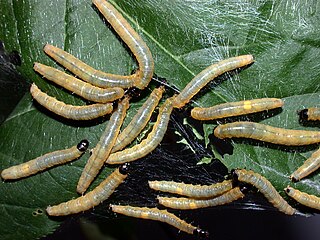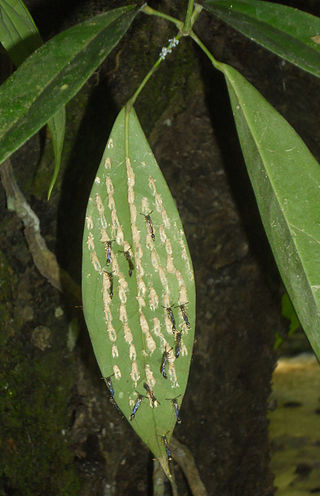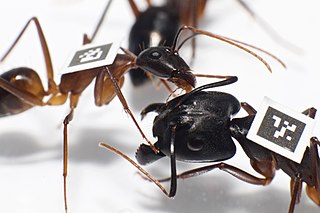Related Research Articles

Carpenter ants are large ants indigenous to many forested parts of the world.

The collective behaviors of social caterpillars falls into five general categories: collective and cooperative foraging, group defense against predators and parasitoids, shelter building, thermoregulation and substrate silking to enhance steadfastness.

The European paper wasp is one of the most common and well-known species of social wasps in the genus Polistes. Its diet is more diverse than those of most Polistes species—many genera of insects versus mainly caterpillars in other Polistes—giving it superior survivability compared to other wasp species during a shortage of resources.

Formica polyctena is a species of European red wood ant in the genus Formica and large family Formicidae. The species was first described by Arnold Förster in 1850. The latin species name polyctena is from Greek and literally means 'many cattle', referring to the species' habit of farming aphids for honeydew food. It is found in many European countries. It is a eusocial species, that has a distinct caste system of sterile workers and a very small reproductive caste. The ants have a genetic based cue that allow them to identify which other ants are members of their nest and which are foreign individuals. When facing these types of foreign invaders the F. polyctena has a system to activate an alarm. It can release pheromones which can trigger an alarm response in other nearby ants.

Eusociality, the highest level of organization of sociality, is defined by the following characteristics: cooperative brood care, overlapping generations within a colony of adults, and a division of labor into reproductive and non-reproductive groups. The division of labor creates specialized behavioral groups within an animal society which are sometimes referred to as 'castes'. Eusociality is distinguished from all other social systems because individuals of at least one caste usually lose the ability to perform at least one behavior characteristic of individuals in another caste. Eusocial colonies can be viewed as superorganisms.

Ropalidia marginata is an Old World species of paper wasp. It is primitively eusocial, not showing the same bias in brood care seen in other social insects with greater asymmetry in relatedness. The species employs a variety of colony founding strategies, sometimes with single founders and sometimes in groups of variable number. The queen does not use physical dominance to control workers; there is evidence of pheromones being used to suppress other female workers from overtaking queenship.

Nasutitermes corniger is a species of arboreal termite that is endemic to the neotropics. It is very closely related to Nasutitermes ephratae. The species has been studied relatively intensively, particularly on Barro Colorado Island, Panama. These studies and others have shown that the termite interacts with many different organisms including a bat that roosts in its nest and various species of ants that cohabit with the termite.

Polistes fuscatus, whose common name is the dark or northern paper wasp, is widely found in eastern North America, from southern Canada through the southern United States. It often nests around human development. However, it greatly prefers areas in which wood is readily available for use as nest material, therefore they are also found near and in woodlands and savannas. P. fuscatus is a social wasp that is part of a complex society based around a single dominant foundress along with other cofoundresses and a dominance hierarchy.

Worker policing is a behavior seen in colonies of social hymenopterans whereby worker females eat or remove eggs that have been laid by other workers rather than those laid by a queen. Worker policing ensures that the offspring of the queen will predominate in the group. In certain species of bees, ants and wasps, workers or the queen may also act aggressively towards fertile workers. Worker policing has been suggested as a form of coercion to promote the evolution of altruistic behavior in eusocial insect societies.

Formica truncorum is a species of wood ant from the genus Formica. It is distributed across a variety of locations worldwide, including central Europe and Japan. Workers can range from 3.5 to 9.0mm and are uniquely characterized by small hairs covering their entire bodies. Like all other ants, F. truncorum is eusocial and demonstrates many cooperative behaviors that are unique to its order. Colonies are either monogynous, with one queen, or polygynous, with many queens, and these two types of colonies differ in many characteristics.

Polybia occidentalis, commonly known as camoati, is a swarm-founding advanced eusocial wasp. Swarm-founding means that a swarm of these wasps find a nesting site and build the nest together. This species can be found in Central and South America. P. occidentalis preys on nectar, insects, and carbohydrate sources, while birds and ants prey on and parasitize them. P. occidentalis workers bite each other to communicate the time to start working.

Liostenogaster flavolineata is an insect that belongs to the wasp family Vespidae. This hairy-faced hover wasp species is predominantly found in South Asian rain forests, especially in Malaysia. Individual colonies of this species are very small, but aggregations of nests allow for interactions between many smaller colonies. Some worker wasps, known as "helpers", will move between multiple nests in an attempt to improve their position in the dominance hierarchy. Its nests are pale-colored and are usually built with mud. Liostenogaster flavolineata is one of the most studied species in the Stenogastrinae.

Agelaia pallipes is a species of social paper wasp found from Costa Rica to Brazil, Argentina and Paraguay. A. pallipes is ground-nesting and is one of the most aggressive wasps in South America. This species is a predator of other insects, including flies, moths, and ground crickets, as well as baby birds.

Polistes biglumis is a species of social wasp within Polistes, the most common genus of paper wasp. It is distinguished mainly by its tendency to reside in montane climates in meadows or alpine areas. Selection pressure from the wasp's environment has led to several idiosyncrasies of its behavior and lifecycle with respect to its relative species in the genus Polistes. It alone among paper wasps is often polyandrous. In addition, it has a truncated nesting season that gives rise to unique competitive dynamics among females of the species. P. biglumis wasps use an odor-based recognition system that is the basis for all wasp-to-wasp interaction of the species. The wasp's lifecycle is highly intertwined with that of Polistes atrimandibularis, an obligate social parasite wasp that frequently invades the combs of P. biglumis wasps.

Liostenogaster vechti is a type of eusocial hover wasp within the family Vespidae. They are typically brown and yellow in color and are considered a passive aggressive species. Their stings are less painful to humans than other social wasps, and they engage in associative nest foundation. They are mostly found on the Malaysian peninsula and are known for living in large clusters of small ring-shaped nests.
Metapolybia cingulata is a species of social paper wasp known for having queens who exhibit usurpation behaviors and also for having flexible behavior groups. It is difficult to tell what a specific wasp's role is just upon observation. Therefore, dissections are usually performed in order to determine the sex, and thus the wasp's role in the colony. The regulating behavior, or nest building, most closely resembles that of primitive Polistes models where a queen solicits liquid from a fellow worker and then takes pulp to initiate building a cell without leaving the nest. In nest building, the amount of water present in the nest as well as the activity of the builders of the nests determines the activity of the colony.

Parischnogaster jacobsoni is a species of social wasp within Parischnogaster, the largest and least known genus of Stenogastrinae. It is distinguished mainly by its tendency to construct ant guards on its nests. Natural selection has led this wasp to have a thick substance emitted from its abdominal glands that allows it to protect its nest from invasions. Parischnogaster as a genus has been relatively unstudied; P. jacobsoni is one of the few investigated species because it has sufficient durability to live near human populations and it has demonstrated unusual resilience to pollution. While P. jacobsoni is a more complex organism than other wasps in Parischnogaster, the genus overall is relatively primitive with respect to social wasps as a whole.

Mischocyttarus mexicanus cubicola is a neotropical subspecies of paper wasp found in the New World. It is a social wasp that demonstrates two different types of nesting strategies, depending upon context. This context-dependent trait makes Mischocyttarus mexicanus cubicola a good model to study social biology within social wasps. In detail, this trait allows for the females of this species to form nests both individually and as co-founders with other females within the same colony. This subspecies is also known to exhibit cannibalism, with M. m. cubicola queens feeding on their own larvae for nourishment when unaided by workers.

Camponotus fellah is a species of ant in the subfamily Formicinae found across the Middle East and North Africa. This species was formally described by Dalla Torre in 1893. A C. fellah queen holds the record for Israeli ant longevity, surviving for 26 years (1983-2009) in a laboratory environment.

Chemical communication in insects is social signalling between insects of the same or different species, using chemicals. These chemicals may be volatile, to be detected at a distance by other insects' sense of smell, or non-volatile, to be detected on an insect's cuticle by other insects' sense of taste. Many of these chemicals are pheromones, acting like hormones outside the body.
References
- 1 2 3 Bos, Nick; Patrizia d’Ettorre (22 March 2012). "Recognition of Social Identity in Ants". Frontiers in Psychology. 3: 83. doi: 10.3389/fpsyg.2012.00083 . PMC 3309994 . PMID 22461777.
- ↑ Hamilton, Andrew. "Social Insect and the Individuality Thesis: Cohesion and the Colony as a Selectable Individual" (PDF). Retrieved 13 November 2013.
- 1 2 Boomsma, Jacobus; Franks, Nigel (June 2006). "Social insects: from selfish genes to self organisation and beyond". Trends in Ecology & Evolution. 21 (6): 303–308. doi:10.1016/j.tree.2006.04.001. PMID 16769429.
- ↑ Karsai, Istvan; Wenzel, John W. (2000). "Organization and regulation of nest construction behavior in Metapolybia wasps". Journal of Insect Behavior. 13 (1): 111–140. doi:10.1023/a:1007771727503. S2CID 11064386.
